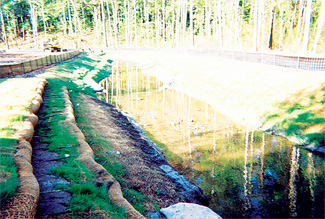

In March, before the ground cover had emerged, the wall remained fully intact. ?EUR??,,????'??So far, it?EUR??,,????'???s performing very well,?EUR??,,????'?? Gray says. ?EUR??,,????'??We designed the slope so that in the future, when the materials biodegrade, the slope will be vegetated at a stable angle. The big test will be in about three years after the coir material degrades and the plant roots are stabilizing the slopes. Then, we?EUR??,,????'???ll know exactly how the project performed. Based on results thus far, I think it will work out well.?EUR??,,????'??
As a result of the initial success of Phase I, Phase 2 of the project will involve stabilizing another 850 ft. section of the streambanks with the coir block and fabric system.
Dealing With the Wrong Soils
This past winter, Bill Stinnett, superintendent for Massana Construction, Marrietta, Ga., supervised a Clayton Country Water Authority streambank restoration project in Morrow, Ga., involving five areas of East Jesters Creek, each about 50 or 100 ft. long and slopes of about 3-5 ft. high. The original plans included wrapping soil in one-ft. high lifts, wrapped in a coir fabric, to build a retaining wall for stabilizing the streambanks. However, Stinnett reports that the soil wasn?EUR??,,????'???t suitable for this. ?EUR??,,????'??We needed some clay to make it work, but the soil was mostly sand and silt and would have washed out,?EUR??,,????'?? he said. The revised plan featured the use of the BioD-Block system.
Thirty-five rock cross vane structures were built to stabilize the stream channel. The base for the retaining wall was prepared by grading it to a depth of 16-in below final grade. Layers of the block and fabric were then installed, with setbacks, to form the finished 2:1 slope to the desired height.
The backfilled structure was seeded with eight varieties of grasses include millet, bermudagrass, fescue and rye. Willow cuttings were used between coir blocks. The project was completed in mid-April 2004. ?EUR??,,????'??Looking back, I wouldn?EUR??,,????'???t have done anything differently,?EUR??,,????'?? Stinnett says. ?EUR??,,????'??The grass came up beautifully and the wall looks great.?EUR??,,????'??
A Wetland Application
The coir block and fabric system was also used successfully by the Massachusetts Municipal Wholesale Electric Co. (MMWEC) of Ludlow, Mass., to restore the banks of six streams following installation of a 20-in. gas pipeline in wetland areas during the summer of 2002. ?EUR??,,????'??The regulatory agencies wouldn?EUR??,,????'???t allow the use of conventional streambank stabilization materials, like riprap,?EUR??,,????'?? explained Mike DiMauro, environmental engineer with the company. ?EUR??,,????'??The site lent itself very well to the biodegradable coir product.?EUR??,,????'?? After regrading the stream banks, single layers of BioD-Block were installed on either side of the steam in appropriate lengths, following the manufacturer?EUR??,,????'???s recommendations. He judged the easy to install, as it was very flexible and conformed to the contours. ?EUR??,,????'??It was very easy to install.?EUR??,,????'?? Following installation of the system, a wetland seed mix was planted over the backfilled area. ?EUR??,,????'??The product has performed very well. Plants are growing up through the fabric and the blocks are slowing degrading as they fill naturally with sediment carried by the stream.?EUR??,,????'??
